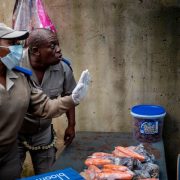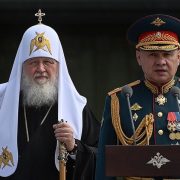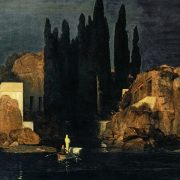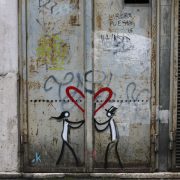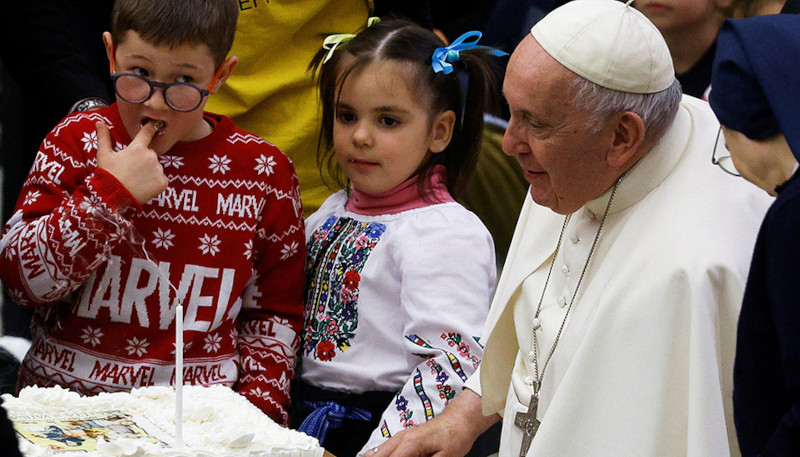
Chinese version below
Behind the many reproaches to Francis about this or that choice, there is a red thread uncovered or covered, as the case may be, but always present. The pope is accused of not dealing with the transcendent, the specific space of religions including catholicis. That is, it is said: he is turning catholicis into an NGO, but this is not so, this is not what religion and the Church do.
The accusation is, therefore, very serious: dismantling the Church and its essence, the contact with God.
A different perspective
Perhaps, however, things should be seen differently.
Looking at the world from Asia, everything seems clearer. Existence is an endless cycle of eating and being eaten. Plants, animals and even humans are within a cycle that eats life to get life, seeks death to get life. It is a ruthless food chain in which plants compete with each other and draw nourishment from the earth, so do animals with plants and with each other, and so do humans.
The modern fascination with Dracula and zombies is the literary exemplification of a profound perception. Men must give death in order to live, but in order to ‘live’ like thise, they become living dead, Dracula (without a shadow, i.e. without a soul) or zombies (even without the ability to reason, only with feral instincts).
Dracula and the zombies seem to represent today’s humanity, which, in the last century and a half, has broken the traditional life cycle, leading to an explosion of the earth’s population, which has increased tenfold, and doubling of the average lifespan, also an unprecedented feat.
In the past, man could live and reproduce within tiny limits, essentially unchanved for hundreds of thousands of years. It was natural, then, that divinity was also perceived by humans in this context.
In line with this fierce chain, many religions in the past – but also today – present a devouring God, who demands sacrifices or wars, as if he were the supreme apex of a food chain that also passes through us. This process is referred to as ‘sacrifice’, that is, the end of something so that something else can begin.
Buddhism, Taoism, Hinduism, the ancient Jain movement knew this beastly cycle. There the solution was, and still is, acceptance of the cycle, i.e. one’s own surrender. Christianity, for the first and only time, announced a God who gets eaten but does not eat, who gets killed but does not kill. Christianity is a religion of God-eaters, of theophagi, deeply scandalous but equally liberating. God does not eat, but allows himself to be eaten in the Eucharist.
This is realised in the effort to slow down, to reduce the cycle of continual devouring. o be good, to love, is to oppose the ruthlessness of impending death. Love ideally and concretely breaks that cycle of life that gives death.
Non c’è nulla di più spirituale di questo. Ci collega con un mondo senza morte, che non conosciamo, e che è al di là della nostra vita.
What Church
Pope Francis’ ‘field hospital’ Church puts us back on track with this tradition all the more necessary today when the multi-millennial cycle of survival of the human race has changed and is changing radically. In other words, the Gospel message is almost more understandable today, in this world, than it was yesterday.
In fact, a ‘monarchical’, ‘princely’ Church would bring Catholicism in line with the many death-hungry ancient religions. But those religions do not make us touch the infinite, rather they push us away from it.
But even those that seek the infinite detached from concrete life only confirm the cycle of the perennial search for death.
It is in everyday life that Christianity offers an answer to the ancient human drama that is even stronger in the modern world.
It is the infinity in the Eucharist, in the gesture of feeding on the body of Christ and doing good that breaks death twice over, feeding on God and giving to others. Here the gift for others, the offering instead of demanding, is the embodiment of the divine gesture of giving oneself as nourishment and conscious sacrifice.
From the outside, the gesture of the gift can exist without the rite of the Eucharist. But if there is only the rite without the gesture of the gift then everything becomes non-empty, worse, it is the reproduction of a gesture of blood of a divinity that wants human and non-human sacrifices.
Against this, Pope Francis warns us with extreme caution, because in any case the life of the Church, the world’s largest unified religion, is a testament to the strength not only of the message but of the practice of this religion in history.
在各种媒体对方济各的这一选择或那一选择的诸多责难背后,有一条红线被揭开或被掩盖(视情况而定)但始终存在。教宗被指责没有注意超验的、包括天主教在内的宗教的特定空间。也就是说,有人说:他把天主教变成了非政府组织,但事实并非如此,信仰和教会并非如此。
因此,这种控告是非常严重的:瓦解教会及其本质,即与天主的联系。
不同的视角
也许,我们应该换个角度看问题。
从亚洲看世界,一切都显得更加清晰。存在就是吃与被吃的无尽循环。植物、动物,甚至人类,都在这个循环之中,以食换生,以死求生。这是一个无情的食物链,植物相互竞争,从大地汲取养分,动物与植物、动物与动物之间也是如此,人类也是如此。
现代人对德古拉和僵尸的迷恋是一种深刻认识的文学例证。人为了活着,必须强加死亡,但为了像他们那样 “活着”,他们变成了活死人,德古拉(没有影子,即没有灵魂)或僵尸(甚至没有理性能力,只有野性的本能)。
德古拉和僵尸似乎代表了当今的人类,在过去的一个半世纪里,人类打破了传统的生命周期,导致地球人口爆炸,增长了十倍,平均寿命也延长了一倍,这也是前所未有的壮举。
过去,人类可以在极小的范围内生活和繁衍,几十万年来基本上没有改变。那么,在这种情况下,神性自然也被人类所感知。
根据这一凶猛的链条,许多宗教在过去–但也在今天–提出了一个需要牺牲或战争的吞噬之神,就好像他是食物链的最高顶点,而食物链也穿过我们。这个过程被称为 “牺牲”,即结束某件事情,以便开始另一件事。
佛教、道教、印度教、古代耆那教运动都知道这种恶性循环。在那里,解决的办法过去是,现在仍然是,接受这个循环,即自己投降。基督宗教第一次,也是唯一一次,宣布了一个被吃却不吃、被杀却不杀的天主。基督宗教是一个食神的宗教,是一个 “theophagi “的宗教。天主不吃人,却允许自己在圣体圣事中被吃掉。
这在努力放慢脚步、减少不断吞噬的循环中得以实现。善,爱,就是对抗即将到来的死亡的无情。爱是理想的,也是具体的,它打破了生命的循环,让死亡降临。
没有比这更具有灵性的了。我们与一个没有死亡的世界相伴,它不为我们所知,却与我们的生活息息相关。
什么是教会
教宗方济各的 “野战医院式 “教会使我们回到了这一传统的轨道上来,在人类生存的多千年周期已经改变并正在发生根本性变化的今天,这一传统显得更加必要。换句话说,在这个世界上,今天的福音信息几乎比昨天更容易理解。
事实上,一个 “君主制”、”亲王制 “的教会将使天主教与许多渴求死亡的古代宗教保持一致。但是,这些宗教并没有让我们触摸到无限,而是把我们推离了无限。
但是,即使是那些脱离具体生活而寻求无限的宗教,也只是在证实常年寻求死亡的循环。
正是在日常生活中,基督宗教为古老的人类戏剧提供了答案,而这一答案在现代世界更加强烈。
这就是圣体圣事中的无限性,在以基督的身体为食和善良的姿态中,两次打破了死亡,以天主为食并给予他人。在这里,馈赠他人,奉献而非索取,体现了奉献自己作为营养和有意识的牺牲的神圣姿态。
从外部来看,没有圣体圣事,礼物的姿态也可以存在。但是,如果只有圣体圣事而没有奉献的姿态,那么一切都不仅会变得空洞,更糟糕的是,这是要人类和非人类祭献的天主的嗜血性呈现。
对此,教宗方济各极为谨慎地告诫我们,因为无论如何,教会这个世界上最大的统一宗教的生命不仅证明她信息的力量,也证明了这个宗教在历史上的实践的力量。


